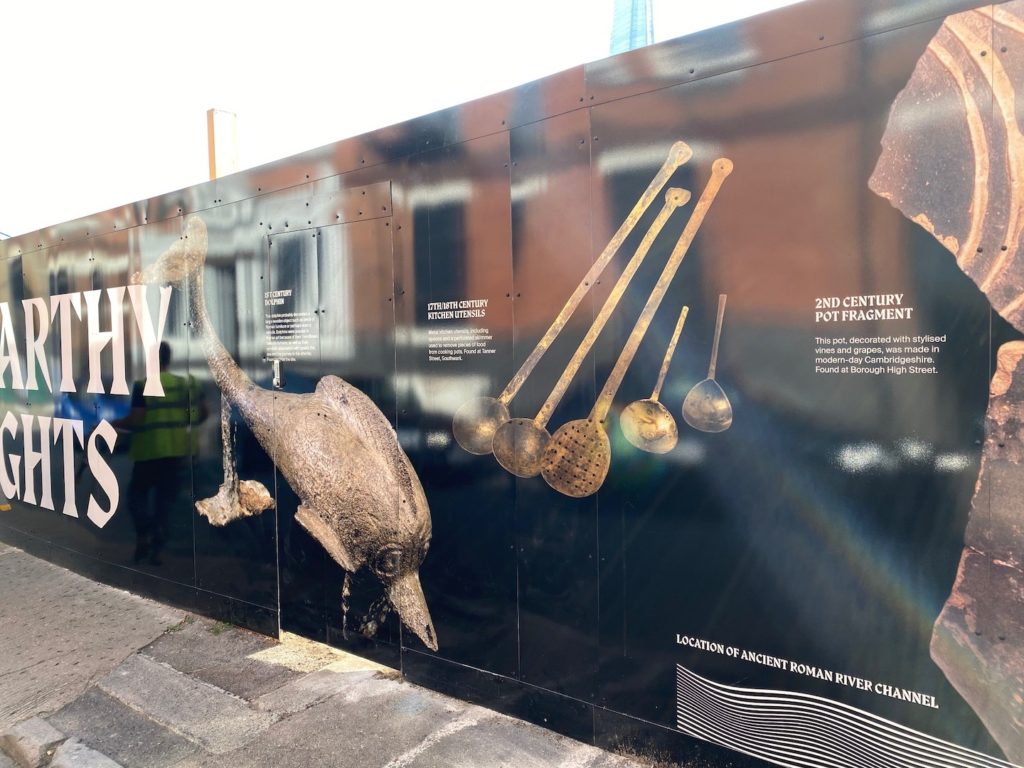Construction site hoardings may be a legal requirement, but more than just another thing on a contractor or site manager’s to-do list – they offer a unique, impactful, and highly effective form of outdoor advertising if used correctly. Many construction sites utilise printed site hoardings, but to make sure you’re making the most of your hoarding graphics, here are a few of PressOn’s top tips:
Pinpoint what your printed site hoardings are for
It may seem fairly obvious at first, but really coming to grips with what your hoarding designs are there to do is a hugely important first step which is surprisingly easy to overlook. Many hoardings end up being adorned with simple branding for the developers of the site, along with the brands or businesses involved – while there’s nothing wrong with this, hoardings can achieve a lot when used right, and understanding your goals for your graphics is crucial.
Take some time to meet with stakeholders and discuss your core goals with your printed site hoardings. Who are your audience, and who are you trying to reach? On this note, who are the local demographics most likely to see your graphics? This should form the cornerstone of your messaging and design.
Similarly, it’s important to understand what you’d ideally like to communicate, not merely to whom. Straightforward branding is a perfectly viable option, but consider exploring other options if there are particular messages, promotions, and more you could benefit from communicating.
Get a great graphic designer on board
To ensure you get your messaging across in the most effective, impactful way possible, you’ll need to enlist the services of a great graphic designer. You may have this capability in house, (which will make the briefing process easier), but if you’re outsourcing you’ll need to make sure you hire someone who is familiar with drafting for large format printing.
If you’re unsure about the specifications, speak with your designer or print firm well in advance of making a commitment to a professional. When you’ve found the right fit, you’ll need to put together a brief that provides as much information about the project and the required messaging as possible. Brand guideline documents are also invaluable.
It’s worth noting that presuming you’ve hired a fantastic, experienced designer, it can be beneficial to embrace a flexible approach to your designs. If your graphic designer suggests changes to your initial concept, be willing to adapt based on their feedback – they’ll likely know more about the kind of designs, messaging, colours, and more that will be most effective. If you embrace this collaborative approach, you can unlock all kinds of unique creative potential.
Consider your local environment
Who are your audience, and who are you trying to reach? On this note, who are the local demographics most likely to see your graphics? This should form the cornerstone of your messaging and design. It should be the basis upon which your entire hoarding design is founded – there’s no point trying to force an irrelevant message upon a local population, even if it’s what you’d ideally like to say.
With this in mind, think about ways you can do more than simply promote your business or brand with your hoardings. Is there a local cultural or historical significance to the project you’re working on? Is there a way you could embrace this with your designs? Alternatively, considering the fact a construction site is often somewhat intrusive to a local area, you could explore ways to communicate the vision and scope of the project – helping viewers better connect with and understand the eventual benefits of the temporary inconvenience of the construction works.
(We’ve written more about how hoardings can be used to engage with a local community here)
Get to grips with rules and requirements
Like any element of a construction project, hoarding graphics are subject to their own set of rules, regulations, and requirements. These apply to both the physical and visual design of the hoardings, so you’ll need to familiarise yourself with how these apply to your project – they can differ between local authorities too, so be sure to speak with the relevant parties to ascertain any requirements.
We put together a guide on some of the most common rules and requirements that apply, and this should form the basis for your design; some authorities place restrictions on the nature of brand advertising on hoardings, for instance, so while a ten-foot print of your logo might communicate your branding to everyone within a five-mile radius, it might not even get the green light.
Collaborate with your print supplier
There’s more to a hoarding graphics project than simply printing and installing your graphics. A good print supplier will work with you at every stage of your project to ensure you have access to all of the necessary information and materials to achieve the very best results. This may mean opting for a specific substrate for your project (such as anti-graffiti panels), or it could be an installation consideration you may not have considered or known about.
A great printing company will work to understand your brief, the physical environment for your project, and will factor in any other potential challenges. This level of expertise can make a big difference to the finished result, ensuring you avoid the need for costly replacement as a result of incorrect materials, and providing you with access to the most vibrant, bold, impressive printing solutions. Take advantage of services such as site surveys and more – the more ‘on board’ your print supplier is during the process, the more seamless the installation will be.
Final Thoughts
While every print project is unique, and every brief will differ, the general recommendations above provide a framework for maximising your hoardings regardless of your designs. Clarity of purpose, process, and planning make all the difference, and exploring the broader potential of your graphics can elevate your project from merely effective to impactful and memorable.
PressOn have been printing and installing hoardings for over 20 years – if you would like to discuss your own hoarding graphics project, don’t hesitate to get in touch; our project managers will be happy to discuss your requirements.




